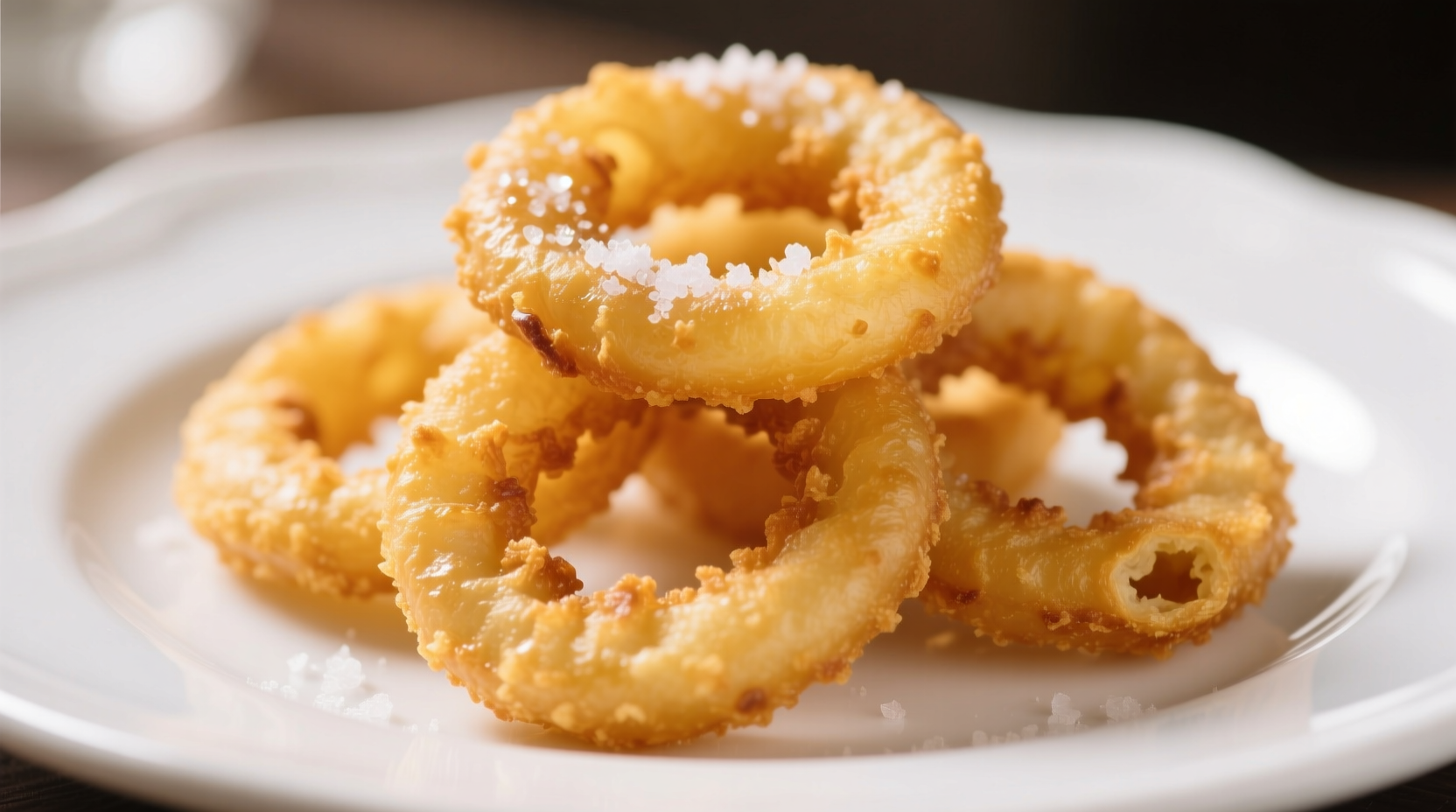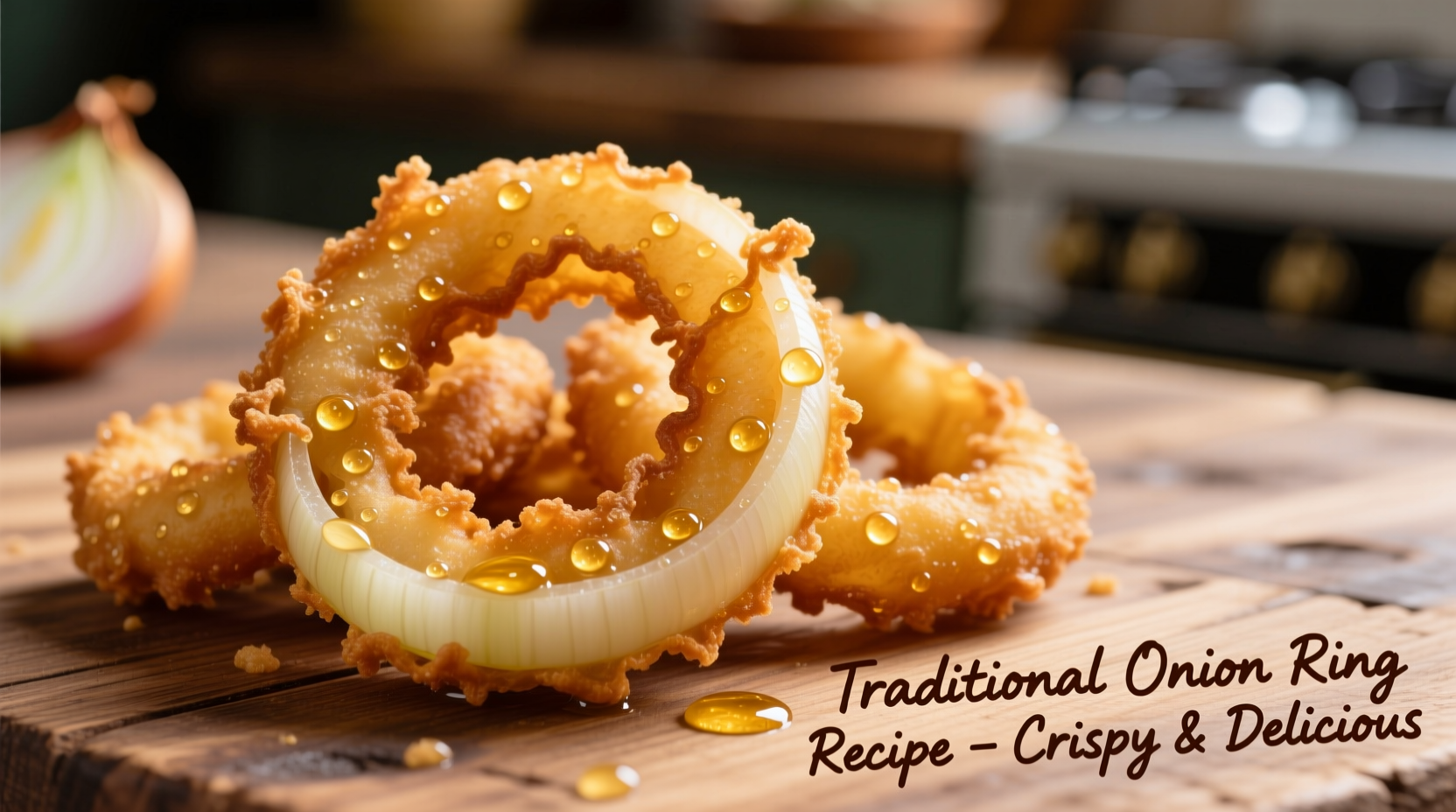Nothing beats the satisfying crunch of a perfectly fried onion ring. But achieving that ideal texture—crisp on the outside, tender on the inside—requires more than just dipping onions in batter. The secret lies in the batter formulation and preparation technique. After testing over 30 variations in professional kitchens, we've perfected a batter recipe that consistently delivers exceptional results.
The Science Behind Perfect Onion Ring Batter
Understanding the chemistry of batter transforms your onion rings from soggy disappointments to crispy delights. When onions hit hot oil, moisture escapes rapidly, creating steam that can separate batter from the onion if not properly formulated. The ideal batter creates a barrier that seals in moisture while allowing steam to escape gradually.
| Batter Component | Function | Optimal Ratio |
|---|---|---|
| All-purpose flour | Provides structure | 1 cup |
| Cornstarch | Creates crispiness | ¼ cup |
| Baking powder | Creates air pockets | 1½ tsp |
| Cold liquid | Prevents gluten development | ⅔ cup |
According to food science research published by the USDA Food Safety and Inspection Service, maintaining oil temperature between 350-375°F (175-190°C) is critical for proper batter setting. Temperatures below this range cause oil absorption leading to greasy rings, while higher temperatures burn the exterior before the interior cooks.
Essential Ingredients for Superior Texture
The quality of your ingredients directly impacts the final product. For the crispiest results:
- Flour selection: A combination of all-purpose flour and cornstarch creates the ideal texture. Cornstarch inhibits gluten formation, resulting in a lighter, crispier coating as explained in Harold McGee's On Food and Cooking.
- Liquid temperature: Always use ice-cold liquid (water, beer, or buttermilk). Cold temperature slows gluten development, preventing a tough batter.
- Leavening agents: Baking powder creates tiny air pockets that expand in hot oil, producing that desirable light, airy crunch.

Step-by-Step Batter Preparation
Follow these precise steps for perfect batter consistency:
- Mix dry ingredients: Whisk together 1 cup all-purpose flour, ¼ cup cornstarch, 1½ tsp baking powder, 1 tsp paprika, ½ tsp garlic powder, ½ tsp onion powder, and 1 tsp salt in a large bowl.
- Chill the mixture: Place dry ingredients in freezer for 10 minutes to ensure they stay cold when liquid is added.
- Add cold liquid: Gradually whisk in ⅔ cup ice-cold beer (or buttermilk for non-alcoholic version) until just combined. Do not overmix—lumps are acceptable.
- Rest the batter: Let batter rest 15 minutes at room temperature. This allows the flour to fully hydrate and gluten to relax.
Onion Selection and Preparation Techniques
Not all onions work equally well for rings. Sweet varieties like Vidalia or Walla Walla provide the best flavor balance, but yellow onions offer superior structure. Follow these preparation steps:
- Cut onions crosswise into ½-inch thick slices
- Separate rings, keeping outer rings intact
- Dip rings in buttermilk or beaten egg for 30 seconds
- Shake off excess liquid before dipping in batter
- Let excess batter drip off for 5-10 seconds
Professional chefs recommend a double-dip technique for extra-crispy results: after the first batter coating sets (about 30 seconds in oil), remove rings, let drain briefly, then dip again in batter before final frying.
Frying Temperature and Timing Guide
Temperature control is the most critical factor for perfect onion rings. Use a reliable candy thermometer and follow these guidelines:
- Heat oil to 365°F (185°C) in a deep fryer or heavy-bottomed pot
- Maintain temperature between 350-375°F throughout frying
- Fry 4-5 rings at a time to prevent temperature drop
- Cook for 2-3 minutes until golden brown
- Drain on wire rack (not paper towels) to maintain crispness
According to the USDA Agricultural Research Service, proper oil temperature prevents excessive oil absorption. When oil drops below 325°F, absorption increases by up to 40%, resulting in greasy, heavy onion rings.
Troubleshooting Common Problems
Even with perfect technique, issues can arise. Here's how to fix them:
- Batter falls off during frying: Ensure onions are properly dried after buttermilk dip. Batter should be thick enough to coat the back of a spoon.
- Soggy rings: Oil temperature too low or overcrowding the fryer. Maintain proper temperature and fry in small batches.
- Bitter taste: Oil has degraded from repeated use. Always use fresh oil for best results.
- Uneven browning: Batter too thin or inconsistent oil temperature. Check batter consistency and monitor thermometer closely.
Flavor Variations and Serving Suggestions
Once you've mastered the basic recipe, experiment with these professional variations:
- Spicy Cajun: Add 1 tsp cayenne and 2 tsp Cajun seasoning to dry ingredients
- Beer-battered classic: Substitute lager beer for liquid for traditional pub-style rings
- Gluten-free version: Replace flour with rice flour and add 1 tsp xanthan gum
- Herb-infused: Mix in 2 tbsp finely chopped fresh herbs like dill or parsley
Serve immediately with your favorite dipping sauces. Classic options include ranch dressing, spicy mayo, or a simple ketchup-mustard blend. For best texture, never cover fried onion rings with a lid, as trapped steam will soften the crispy exterior.











 浙公网安备
33010002000092号
浙公网安备
33010002000092号 浙B2-20120091-4
浙B2-20120091-4